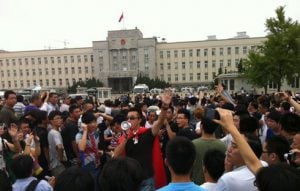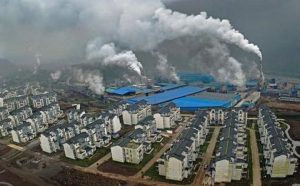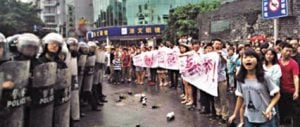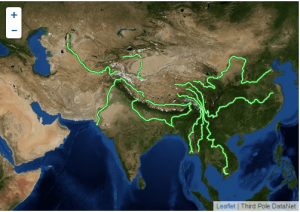The Sichuan city of Shifang saw mass protests against a proposed molybdenum and copper project in the Summer of 2012. Subsequently Shifang found itself marginalised and its economic growth suffered. With deadlock over restarting the project, the city is in the doldrums. But Li Zhuo, the city’s Party secretary, said it is a “national problem”.
On July 2, 2012, residents of Shifang, who were worried about pollution from a proposed 13.7 billion yuan (US$2.2 billion) Hongda Group molybdenum and copper-processing plant, stormed the offices of the city Party committee. They were dispersed by police with tear gas and stun grenades. In the two years since, the city has become isolated.
Under huge pressure, the city’s Party secretary at the time, Li Chengjin, quickly promised that the project would not go ahead without public support.
But two years later, the after-effects of the protests still trouble the city.
The 2012 protest came at a time of uncertainty. The GDP growth rate for 2012 was 7.7%, a 13 year low. Shifang’s economy relies on the food and chemicals industries, both of which were showing fatigue after years of rapid growth. In particular the city’s phosphorous sector was suffering from a drying up of reserves and environmental concerns.
In May this year the city Party committee issued a downbeat report: “If the transformational possibilities of the molybdenum and copper project are lost due to backwards thinking, it is unlikely industrial development in the city will improve in the coming years, or for an even longer period.”
Shifang has always been an industrial city and it long boasted the province’s second-largest economy. But damage done by the Wenchuan earthquake in 2008 knocked it out of the top 10. And many officials say that nothing bar that earthquake has done as much damage to the city’s economy as the July 2012 protests: “It completely rocked business confidence,” said Li Zhuo.
Shifang marginalised
In October 2012, three months after the protest, Li Zhuo was appointed Party secretary.
According to Li, people in the metals industry “hate the very name of Shifang. It seems like the Shifang protests ruined the image of the industry.”
One official, preferring to remain anonymous, said that “for a whole year not a single provincial leader, not a single department head, visited Shifang. Not one.” In Chinese politics, that means you’ve been marginalised.
Shifang, and the damage done to the Party’s governance, is now used as a case study in mass-line training for the entire Communist Party. In July 2014, the Party’s leading group on mass line training published an “Analysis of Case Studies of Harm to the Mass Interest”. This included a section on Shifang – why did a beneficial project not receive public support, and what could be learned from the case. Along with Weng’an in Guizhou and Wukan in Guangzhou, Shifang is now held up as a warning to all Party members.
Before Chinese New Year in 2013, Zhang Zhouyu, a village Party secretary and city People’s Representative proposed restarting the project.
Speaking to Southern Weekend, Li Zhuo said his own efforts were directed to winning public “understanding and support”.
In March 2013, a systematic attempt to set the record straight was launched, aimed at government superiors, the public, the media and the market. As part of this, 1,210 teams were sent to speak at every one of Shifang’s villages and neighbourhoods.
But the wounds are not so easily healed. Many local officials think that residents lost faith in government when the armed police were sent in. One witness recalls that “nobody would even sell them a meal. The supermarkets wouldn’t even sell them a bottle of water.”
Ulterior motives
In September 2012, the National Development and Reform Commission ordered the establishment of a system for assessing social risks of major projects. This was less than two months after the incidents in Shifang and Qidong.
Shan Guangnai, a Chinese Academy of Social Sciences expert on mass protests, heads a research team which spent six months interviewing 3,000 Shifang residents about the molybdenum and copper project. “One third were in support, one third had no particular view, and one third opposed it.”
The interviews changed Shan’s original view of the protests, which were commonly described as motivated by "nimby" concerns – locals objecting to a new project and taking to the streets. “It clearly wasn’t, it was motivated by interests.” According to Shan a clash of differing interests lead to the protests – villagers near the proposed project weren’t protesting.
Speaking in October this year, Leng Changfu, a resident of the village of Yinchi, said that “we wouldn’t go and protest, even now we’re angry we aren’t getting the money for our land [which the village is not paying].” A kilometre away, in the village of Yujiang, a local told Southern Weekend that “I can guarantee that nobody in that village had heard there was a protest that day.” Shan’s survey confirmed that the residents in the surrounding area are in favour of the project, or at least not opposed to it.
In May this year the city Party committee published a document partially explaining the story of the protests: “Certain people with ulterior motives used public environmental concerns to incite those who did not understand the truth to act irrationally, ultimately ending in a mass incident.”
“The causes of the protests were complex,” said the above source. One was that the project caused panic among small chemical firms: “A new big project would result in smaller firms being closed down,” said the city’s environmental protection chief, Zeng Shengqi. That same fate had already befallen the city’s small concrete makers: the city government persuaded a major concrete-making firm to set up a plant, and subsequently many smaller operations were shut down. In addition, the molybdenum and copper plant would compete with small sulphuric-acid plants.
The food sector was also a staunch opponent. Government activities to explain the project were boycotted by a cigarette factory and a drinks company. According to an informed source, “the cigarette and drinks factory were worried the project would affect the value of their brand.”
A national problem
Shifang is left with few choices. On June 28 the project owner, Hongda Group, said that any financial losses due to the cancelling of the project must be made good by the end of 2015. According to the informed source, the company has spent around 200 million yuan (US$32 million), and indirect losses could be incalculable.
The problem is, the project has been given all the legal licences required.
For the city managers, Hongda’s demands for compensation are the most pressing issue. An official with the city Party committee explained: “If they sue, the government has next to no chance of winning. The project was all done legally, but we stopped it going ahead.”
The city originally planned a hearing on the project for the first half of this year, but is still not fully prepared. Li Zhuo said that “hearings are one way of making decisions, but it’s not a legally prescribed method. If we hold the hearing and representatives agree, can I start getting the project back on track?”
At a seminar on environmental protests held in Beijing earlier this year one expert even suggested that the overseas practice of a referendum be adopted, with all 430,000 residents of Shifang deciding if the project should stay or go.
In mid-October, the Ministry of Environmental Protection submitted a document to the Central Committee, saying that if the Shifang deadlock was not broken there would be no hope for China’s economic transition. Li Zhuo said that “the issue is stuck here in Shifang. It reflects the problems of our economic transition, and that’s a national problem.”
This article was originally published by Southern Weekend







